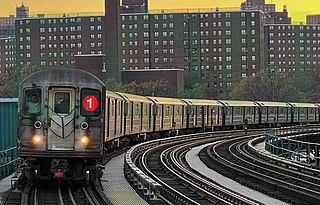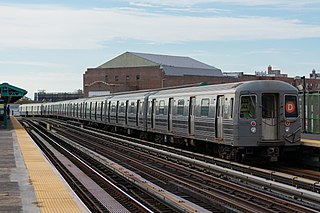
The C Eighth Avenue Local is a 19-mile-long (31 km) rapid transit service in the B Division of the New York City Subway. Its route emblem, or "bullet", is blue since it is a part of the IND Eighth Avenue Line in Manhattan.

The R142 is the first mass-produced model class of the newest generation or new technology (NTT) A Division cars for the New York City Subway. It was built by Bombardier Transportation in La Pocatière, Quebec, Canada and Barre, Vermont, U.S. with final assembly performed at Plattsburgh, New York, from 1999 to 2003. There are 880 cars numbered 6301–7180 and another 150 cars numbered 1101–1250, for a total of 1,030 cars, all arranged as five-car sets. Together with the R142As, they replaced the Redbird trains, including the R26, R28, R29, R33, R33S, and R36.

The R142A is the second order of new technology cars (NTTs) for the A Division of the New York City Subway. These cars were built by Kawasaki Heavy Industries in the U.S. at Yonkers, New York and Lincoln, Nebraska, and in Japan at Kobe, Hyōgo. They replaced the Redbird trains, including the R26, R28, R29, R33, R33S, and R36. The R142A fleet initially comprised 600 cars, arranged as five-car units.

The R46 is a New York City Subway car model that was built by the Pullman Standard Company from 1975 to 1978 for the IND/BMT B Division. They replaced all remaining R1–9 fleet cars and General Electric-powered R16s, and some R10s. The R46 order initially consisted of 754 single cars, each 75 feet (23 m) long, and was the largest single order of passenger cars in United States railroad history at the point of the fleet's completion. The R46 was the second order of 75-foot cars to be ordered for the New York City Subway, after the R44s.

The R44 is a New York City Subway car model built by the St. Louis Car Company from 1971 to 1973 for the B Division and the Staten Island Railway (SIR). The cars replaced many R1-R9 series cars, and all remaining 1925 Standard Steel built SIRTOA ME-1 trains, providing Staten Island with a new fleet of railcars. The R44 fleet originally consisted of 352 cars, of which 57 remain in service, all on the Staten Island Railway.

The R42 was a New York City Subway car model built by the St. Louis Car Company between 1969 and 1970 for the IND/BMT B Division. There were 400 cars in the R42 fleet, numbered 4550–4949. It was the last 60-foot (18.29 m) B Division car built for the New York City Subway until the R143 in 2001, and the last car model class to be built in married pairs.

The R62 is a New York City Subway car model built between 1983 and 1985 by Kawasaki Heavy Industries in Kobe, Japan, for the A Division. A total of 325 cars were built, originally as single units. When the reliability of the fleet improved, they were converted to five-car sets. The cars replaced the remaining R12s, R14s, and R15s, which were all retired by the end of 1984.

The New York City Subway is a large rapid transit system and has a large fleet of electric multiple unit rolling stock. As of November 2016, the New York City Subway has 6418 cars on the roster.

The R110B was a prototype class of experimental New Technology Train (NTT) New York City Subway cars built by Bombardier of Canada for service on the B Division services. There were nine cars, arranged as three-car sets. They were designed to test features that would be implemented on future mass-production NTT orders.

The R110A was a New York City Subway car model built by Kawasaki Heavy Industries in 1992 as a prototype New Technology Train to test various technologies. There were ten cars arranged as five-car sets. They were designed to test features that would be implemented on future mass-production New Tech Train orders.

The R62A is a New York City Subway car model built between 1984 and 1987 by Bombardier Transportation for the A Division. The cars were built in La Pocatière, Quebec, with final assembly done in Auburn, New York and Barre, Vermont, under a license from Kawasaki Heavy Industries, manufacturer of the previous R62 order. A total of 825 cars were built, arranged as sets of three, four, or five cars per set. The cars replaced the remaining R17s, R21s, and R22s, which were all retired by early 1988.

The R68 is a B Division New York City Subway car order consisting of 425 cars built by the Westinghouse-Amrail Company, a joint venture of Westinghouse, ANF Industrie, Jeumont Schneider, and Alsthom. The cars were built in France from 1986 to 1988 and shipped through New York Harbor. Of the cars in the fleet, 416 are arranged in four-car sets while the other nine are single cars.

The R143 is a class of New Technology Train subway cars built by Kawasaki Rail Car Company for the New York City Subway's B Division. Delivered between 2001 and 2003, the cars displaced R40s and R42s that operated on the L service in conjunction with the BMT Canarsie Line's signal system being automated.

The R10 was the first series of post-war New York City Subway cars. They were built by the American Car and Foundry Company from 1948 to 1949 for the IND/BMT B Division. A total of 400 cars were built, arranged as single units. Two versions were manufactured: Westinghouse (WH)-powered cars and General Electric (GE)-powered cars. The R10s introduced many innovations, including an all-welded low-alloy high tensile (LAHT) steel construction, dynamic braking, improved propulsion, and various cosmetic features.

The R16 was a New York City Subway car model built by the American Car and Foundry Company from 1954 to 1955 for the IND/BMT B Division. A total of 200 cars were built, arranged as single units. Two versions were manufactured: Westinghouse (WH)-powered cars and General Electric (GE)-powered cars.

The R30 was a New York City Subway car model built by St. Louis Car Company from 1961 to 1962. The cars were a "follow-up" or supplemental stock for the B Division's R27s and closely resembled them. A total of 320 cars were built, arranged in married pairs. Three versions were manufactured: Westinghouse (WH)-powered cars, General Electric (GE)-powered cars, and R30As.

The R160 is a class of New Technology Train subway cars built for the New York City Subway's B Division. Entering service between 2006 and 2010, they replaced all R38, R40, and NYCT-operated R44 cars, and most R32 and R42 cars. The R160s are very similar to the earlier R143s and later R179s. The biggest difference between the R160 and R143 is the Flexible Information and Notice Display (FIND) system on the R160s in place of static LED maps on the R143s and all A-Division New Technology fleet.

The R188 is a class of new technology (NTT) New York City Subway cars built by Kawasaki Heavy Industries for the A Division. The fleet entered service in 2013, displacing the 1980s-era R62A cars that operated on the 7 and <7> services, in conjunction with the automation of the IRT Flushing Line's signal system with communications-based train control (CBTC). The R188 order also expanded the 7's fleet as part of the 7 Subway Extension, which opened in 2015.

The R211 is a new technology train (NTT) New York City Subway car being built by Kawasaki Railcar Manufacturing for the B Division and the Staten Island Railway (SIR). They will replace two aging subway car models: all R44 cars on the Staten Island Railway and all R46 subway cars. The order is split into three parts: R211A and R211T cars for the subway and R211S cars for the SIR. The R211Ts employ open gangways between cars, allowing passengers to see and walk through the entire length of the train – a feature not present on the subway's other rolling stock. The base order consists of 535 cars, with options for up to 1,077 additional cars.

New Technology Trains (NTT) are the terms for the modern passenger fleet of the New York City Subway that has entered service since 2000. This includes the current R142, R142A, R143, R160, R179, R188 and R211 models, along with the planned R262 and R268 models, along with the 2 prototypes, the R110A and R110B, that were used to test the features that would be found on all NTT trains today.





















